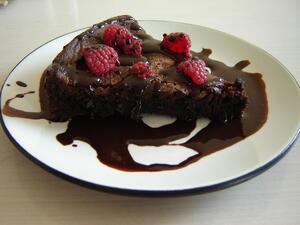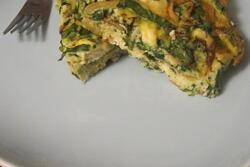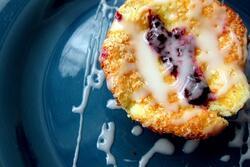How to Pull Off Passover
The brisket I’m serving for Passover this year is going to cost $41.76. That’s the price for six pounds of grass-fed, locally raised and slaughtered beef, courtesy of the University of Arizona’s agriculture department and meat lab. $41.76 for just one component of the meal feels extravagant—but it’s my first time hosting a holiday dinner entirely on my own, and I am eager to playact maturity by purchasing ethically-sourced meat.
There’s the issue of the actual Seder plate—I don’t own one. One lazy Google search for Seder plates cheap has resulted in weeks of targeted ads following me from browser to browser. I was halfway to purchasing a $150 Kate Spade plate, my fingers poised to drag the item into my online cart, before I snapped out of it.
My parents are mailing me Haggadot (multiple Haggadahs), because I wanted to set my table with uniform booklets, and I could only afford one of the Marvelous Mrs. Maisel promotional Haggadahs off of Amazon. (I don’t drink coffee, and the tie-in requires the purchase of Maxwell House products.) There will be just enough for everyone to share with a partner—but who knows how much of the reading we’ll actually get through.
I’ve devised a menu, and thought about assigning different dishes to my attendants, but it feels strange asking my friends (especially the non-Jewish ones) to source Kosher wine and figure out how to make matzo brei. I’ve already invited people to spend their Saturday night learning, so it seems like the least I can do is handle the ins and outs. As a result, my to-do list keeps growing. I’ve blocked out most of the day before my Seder to cook, because I’ve come to understand that preparing all the food you intend to serve on the day of the actual event is for suckers. (I’m hopeful that my fridge can handle the level of food storage I plan to subject it to.)
Despite the fact that I’ve vastly overcommitted myself, I’m secretly enjoying the stress that comes with executing a large event. I am excited by the thought of finally settling in at the head of the table, watching people I care about try the dishes I’ve labored over. I am thrilled by the prospect of being a quasi-expert for the evening, of sharing the story of Passover as an adult amongst friends. My parents are always quick to remind me that at the first Seder they hosted during my childhood, I slumped down in the chair, talked over my father reading, and bolted after the dinner course was served. It’s well within their right to tease and reminisce on how much has changed; they raised me, and had to suffer through my temper tantrums when I was too young to appreciate the ritual I was being asked to sit through. Choosing to embrace traditions as an adult isn’t a do-over—it’s an entirely different experience. If I slump in my chair next week, it’s because I am satiated, and besides, aren’t we meant to recline as free people during the Passover meal?
Since I’m a first-time Seder host, I’m keeping it simple dessert-wise, and serving a flourless chocolate cake with ganache. Here are the recipes!
Flourless Chocolate Cake with Ganache
Adapted from Bon Appetit and Martha Stewart CookingCake Ingredients:
¾ cup (1 ½ sticks) unsalted butter, plus more for pan
12 oz. good-quality bittersweet chocolate
6 large eggs
1 ¼ cups granulated sugar
1 tsp. Kosher salt
1 tsp. Vanilla extract
1 cup cold heavy cream
Ganache Ingredients:
8 ounces of good-quality semisweet chocolate
1/8th tsp. Kosher salt
1 cup heavy cream
Directions
To make the cake:
1. Preheat oven to 325°. Butter bottom and sides of a 9" round cake pan (make sure pan is at least 2" deep). Line bottom of pan with parchment paper.
2. Chop the chocolate good-quality bittersweet chocolate into pieces. Transfer to a medium saucepan.
3. Add butter to saucepan and cook over low heat, stirring occasionally, until butter and chocolate are melted, about 8 minutes.
4. Remove pan from heat and let cool to room temperature, about 15 minutes.
5. Meanwhile, using an electric mixer, beat eggs, sugar, 1 tsp. kosher salt, and vanilla in a large bowl until pale yellow and fluffy, 8–11 minutes. You’ll know it’s ready when the egg mixture has almost tripled in size.
6. Pour in chocolate mixture. Gently fold two mixtures together with a rubber spatula by scooping underneath, then cutting through the middle with the side of the spatula. Do not overmix!
7. Pour batter into prepared pan. Bake cake until a thin, dry crust has formed on the surface, and cake has risen and is firmed up but still wobbles ever-so-slightly in the center underneath the crust, 30-40 minutes. Transfer the pan to a wire rack and let cake cool in pan for about 10 minutes.
8. Place a large plate over pan. Using a towel to protect your hands, invert plate and pan; cake should come out on its own. Lift pan off, then peel off parchment.
9. Gently place a flat platter or cake stand onto cake and invert again. Be careful because this cake is very delicate! Let cake cool to room temperature.
10. When cake has cooled, make ganache mixture.
To Make the Ganache:
1. Coarsely chop chocolate. Use a serrated knife, if possible.
2. Bring cream just to a boil over medium heat. Pour over chocolate, and add salt. Let stand for 10 minutes (don't stir -- doing so will cool the ganache too quickly, making it grainy).
3. Stir with a whisk until smooth and shiny to break up any pieces and emulsify cream and chocolate.
4. Scrape the dish with a rubber spatula to incorporate all ingredients together.
5. Let ganache cool to room temperature, stirring often, 45 minutes to 1 hour. Beat it with a mixer on medium-high speed until fluffy, which takes about 3 minutes. Transfer to a pastry bag with a large opening and gently frost the flourless cake, smoothing with a knife for your desired coverage.








You care about kosher wine but are serving a dairy dessert after your brisket? Guessing the brisket isn't kosher either. Just saying..